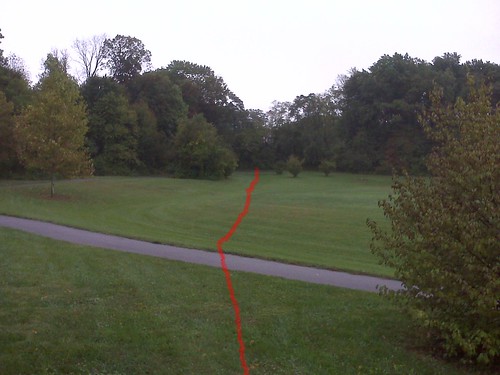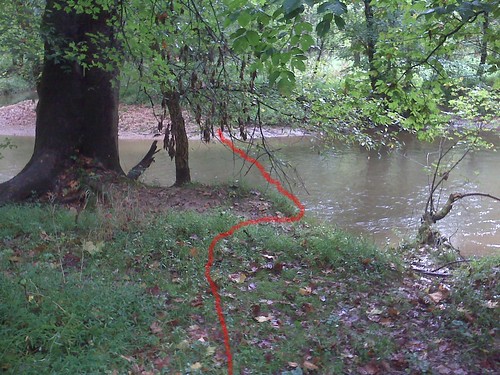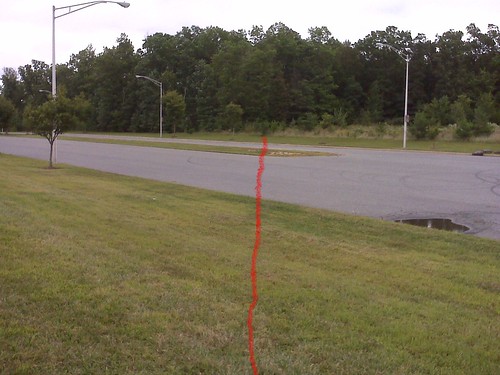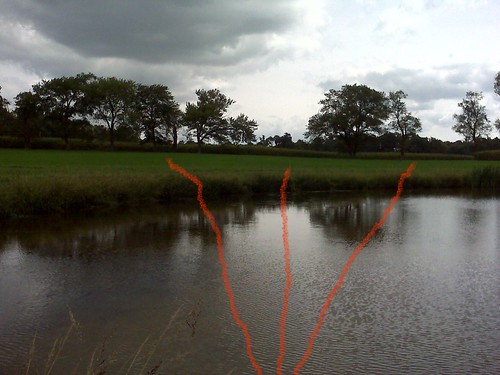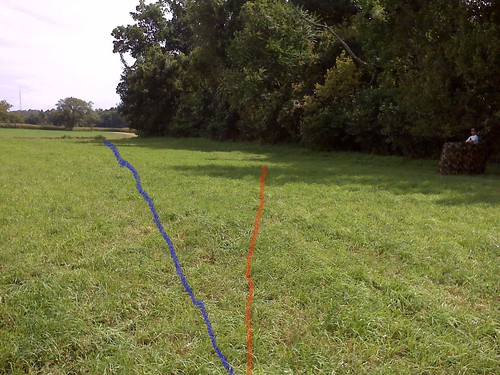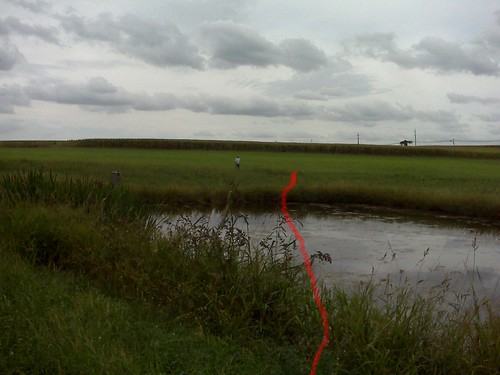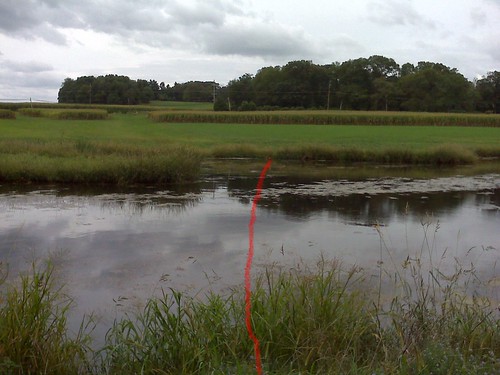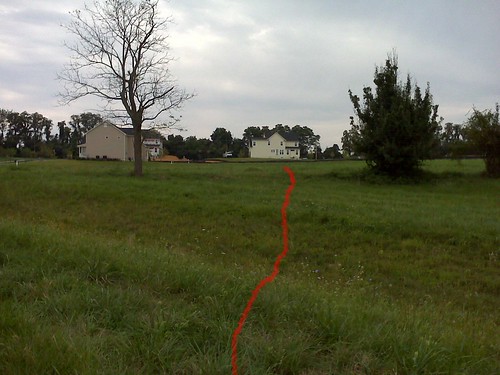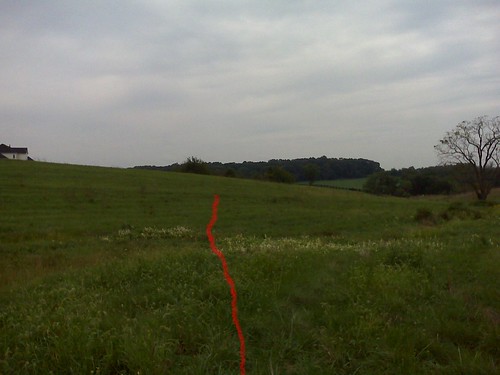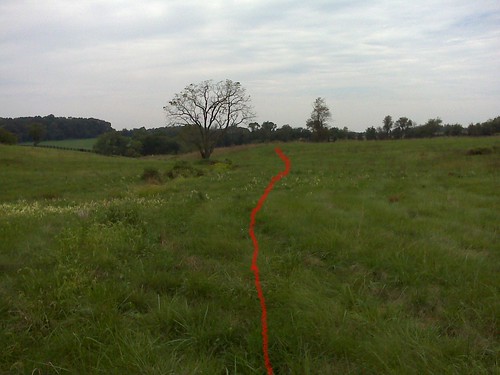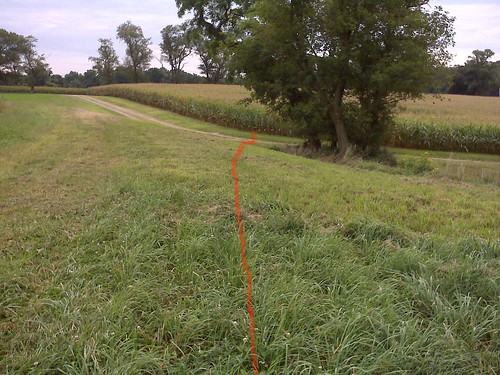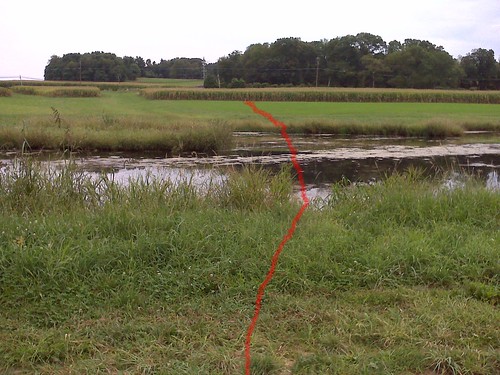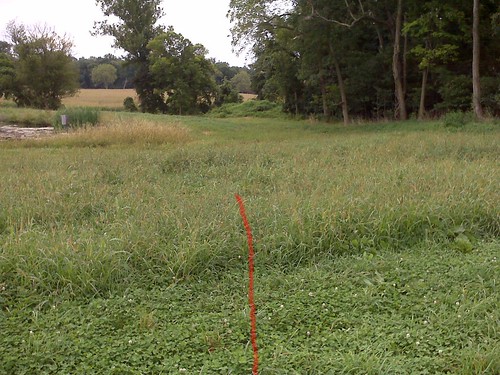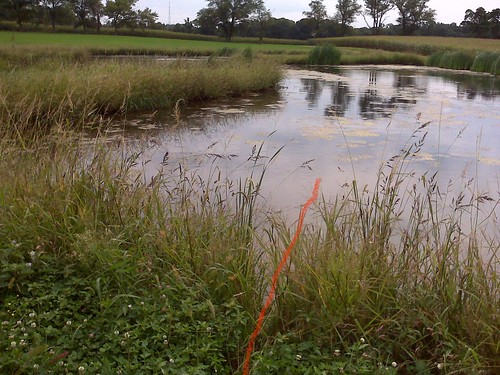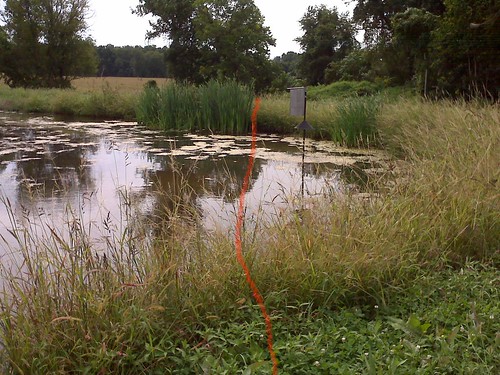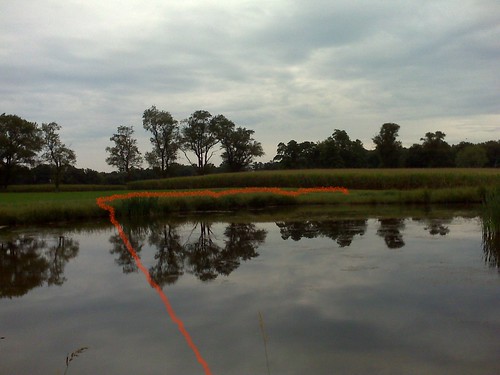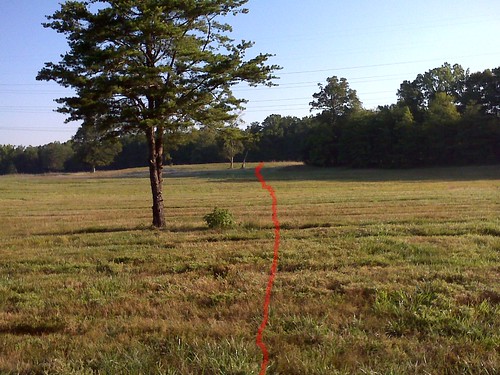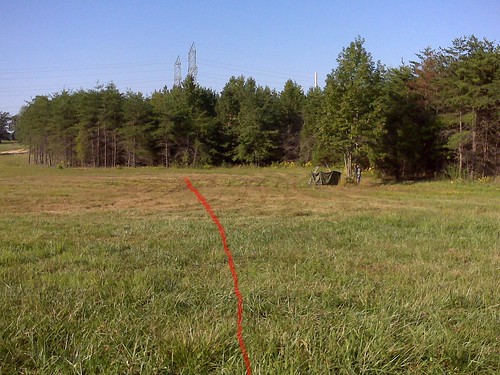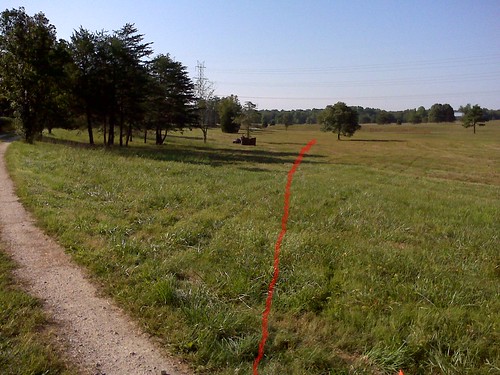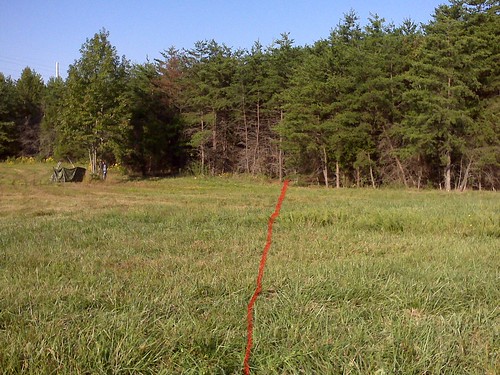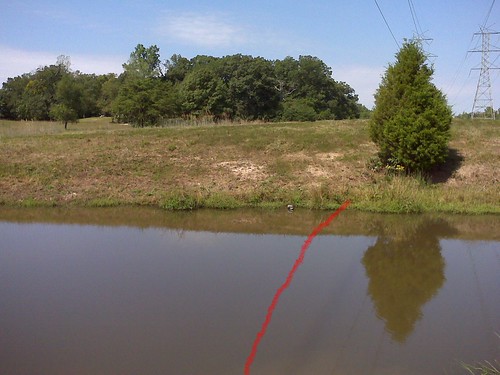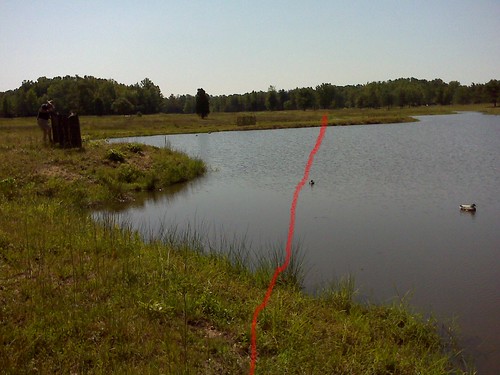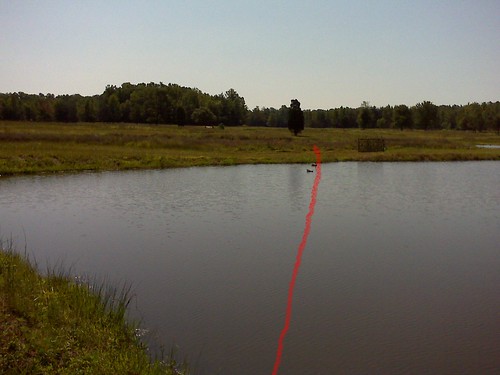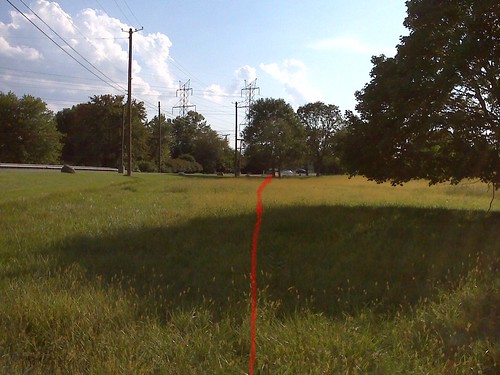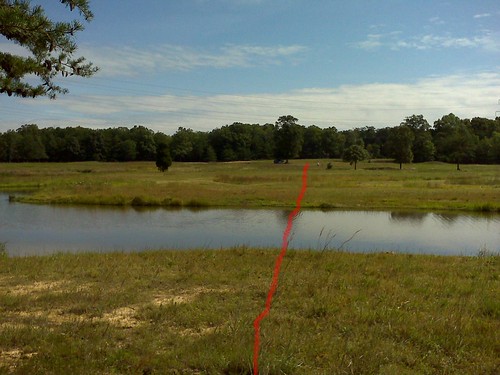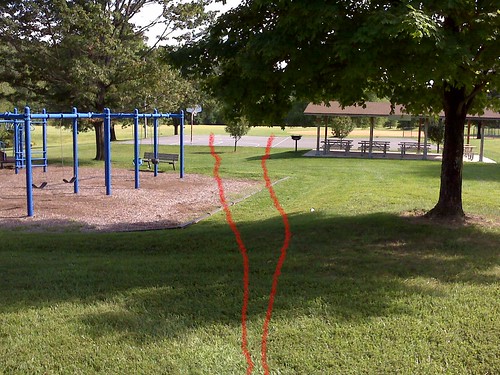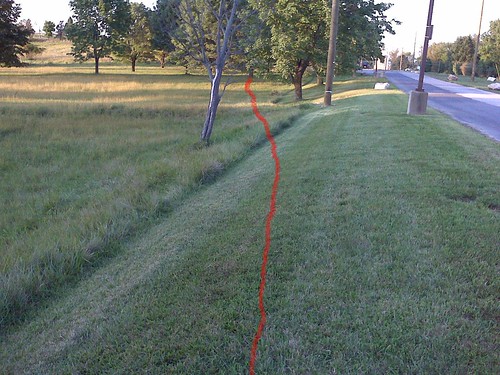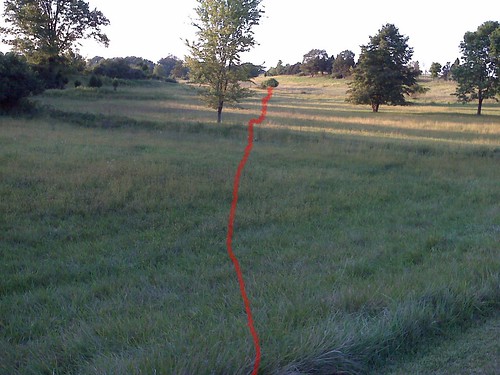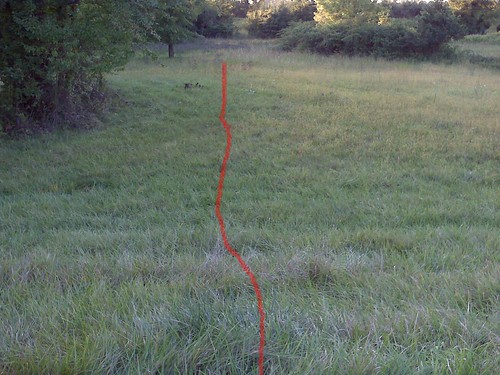Lucky Hill Road (Remington, VA)On the way to the group training site, I spotted an area where the dogs could air and run a couple of warm-up blinds.
SERIES A. Double land blind (Laddie, then Lumi)
The first blind (OD) was on the right at 60 yards. The line to the blind slanted across a dirt road and ended a few yards past a large tree at the edge of a section of woods.
The second blind (OD) was 45° to the left at 120 yards. The line to the second blind crossed the same dirt road, then went diagonally across a parking lot and across an area of mowed grass, and ended at the edge of a section of woods. Two outcroppings of the wooded area provided suction to the right, and an opening in the woods to the left of the blind provided suction in that direction when the dog got close to the blind.
Both dogs aired during this stop. My intent was that as a result, the dogs would not stop on their retrieves during group training. That worked for the first group series (Series B below), but both dogs did end up stopping during their second group series (Series C below) even though I attempted to air them before running them in that series.
Both dogs were responsive on all WSs and casts during Series A and did a nice job on their retrieves.
Photos of Series A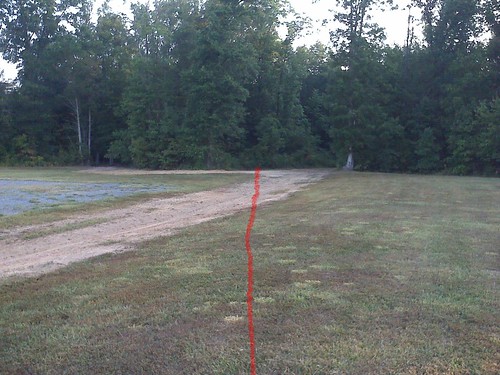 Series A's 60-yard blind
Series A's 60-yard blind Series A's 120-yard blindShady Grove Kennels (Remington, VA)
Series A's 120-yard blindShady Grove Kennels (Remington, VA)This was a monthly group training day. In this post, I describe the first group series "Series B", and the second group series "Series C".
SERIES B. Double consisting of a water mark and a land mark, plus a water blind and a land blind (Laddie, then Lumi)The memory-bird (duck) of the converging double was on the left, thrown left to right with a winger at 30 yards into high cover on the far side of a narrow inlet of water. The go-bird (duck flier) was 60° to the right, thrown right to left with a winger and shot at 80-yards. The line to the go-bird was on land, mostly thru medium-high cover.
The first blind (duck) was across water, then under the arc of the memory-bird and to a point 60 yards from our SL, marked with a lining pole. The second blind (B&W dummy) was from a different SL. The line to the 50-yard second blind was thru a wooded area and a keyhole formed by two trees, ending at an LP at the edge of a section of woods.
The line to the memory-bird required a sharp angle entry, causing the majority of dogs, including Laddie, to cheat around the water on the right. I moved our SL closer to the water to run Laddie hoping to avoid the cheat, but it didn't work. I then moved our SL even closer to the water when it was Lumi's turn.
Laddie's performance on this series had several behavioral problems. First, as we approached my intended SL, he ran ahead and jumped in the water, apparently to cool off in the hot weather. When I got him back to the SL, he did fine on the go-bird flier, but he cheated around the water on the short memory-bird. Worst of all, I think, was that on his return from the memory-bird, he stopped to roll in some high grass. Laddie had no problem with either blind.
With Lumi, I brought her right to the edge of the water. Unfortunately, Lumi forgot the memory-bird by the time she ran it as part of the double and ended up swimming across the channel well to the left of the correct line, and I was unable to handle her to the mark with a reasonable number of WSCs. At the suggestion of the "judge", I called her back to me across the channel and we ran the mark again as a single. Lumi did fine, taking the angle entry and making no effort to cheat to the right. Lumi needed more handling on both blinds than Laddie, and was especially affected by the suction from the area of falls for the memory-bird of the double, which was only a few yards to the right of the line to the first blind.
The photos are in the sequence the retrieves were run.
Photos of Series B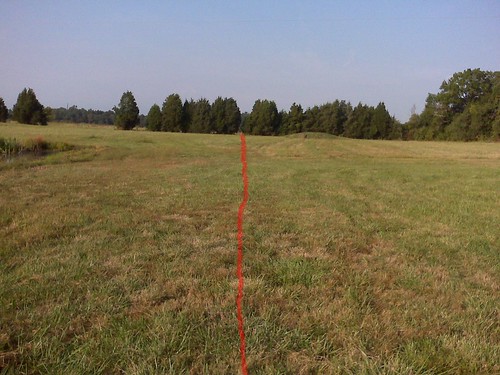 Series B's 80-yard go-bird
Series B's 80-yard go-bird Series B's 30-yard memory-bird (red line) and 60-yard first blind (blue line) under the arc of the memory-bird's throw
Series B's 30-yard memory-bird (red line) and 60-yard first blind (blue line) under the arc of the memory-bird's throw Series B's 50-yard second blindSERIES C. Water double, water single, and water blind (Laddie, then Lumi)
Series B's 50-yard second blindSERIES C. Water double, water single, and water blind (Laddie, then Lumi)While some trainers ran this series as a triple and a blind from a separate SL, and some ran it as three or fewer singles with or without the blind, I decided to follow the lead of one of the other trainers: Lumi and Laddie ran this series as a double and then a single, before running the blind from a separate SL.
The memory-bird (duck) of the double was on the right, thrown right to left with a winger from behind a stand of cattails at 70 yards. The line to the memory bird slanted down an embankment, took an angle entry into a corner of the pond, and an angle-entry out of the water to the bird a few feet inland from water's edge.
The go-bird (duck) of the double was 90° to the left, thrown right t0 left with a winger at 60 yards. The intent was that the go-bird would land in open water, and that's where it landed for Lumi's series, but for Laddie, the go-bird fell short and landed in a section of cattails just past the shoreline. Even for Lumi's series, the go-bird was not visible once it had landed, but was hidden by a point of land.
The line to the single (duck) was 15° to the left of the line to the left mark of the double. The 50-yard single was thrown left to right with a winger not visible from the SL, and landed amongst a cluster of trees and in medium-high cover near water's edge. In some cases including Laddie's series, the bird hit branches of one of the trees when thrown and landed short, making it even more difficult to see the fall from the SL. Wherever the single fell, the line to the fall was on a slant down the embankment from the SL, an angle entry into the water, thru a narrowing of the water closely passing an area of high thick cover made up mostly of cattails on the left, across another short area of water, and a short ways inland into the cluster of trees after reaching the far shore.
The blind consisted of a 60-yard shoreline swim, with old, gray trees on the left creating a channel with the shoreline for the dog's line to the blind. The blind itself was a dummy placed a few yards inland from the far shore. Because of the high cover and terrain at water's edge, the dummy was not visible until the dog had climbed out of the water and thru the cover at water's edge.
Laddie did a nice job on the double. Laddie's go-bird seemed especially difficult, because for some reason it had fallen into a thick section of reeds at water's edge rather than over those reeds and into the open water, as it was thrown for the other dogs. Nonetheless, Laddie ran straight to the fall and boldly plunged down into the water for the pick-up, then clambered back up and raced home, making it look easy.
However, after completing the double and watching the single thrown (it hit a tree branch and like the go-bird of the double, fell short), Laddie did a terrible job retrieving the single. He swam straight to it, but when he got to the area of the fall, instead of picking up the duck, he ate grass, peed a couple of times on nearby trees, and dawdled in other ways before finally picking up the bird and completing the return. As I understand it, while judges are not thrilled with dogs who dawdle, pee, etc. after picking up the bird, they are especially hard in their scoring of dogs who do those things
before they've picked up the bird, as was the case with Laddie on this retrieve.
Lumi did a nice job on all her retrieves in this series. She swam around the point on the memory-bird instead of climbing over the point, but I felt it was still a good Senior-level retrieve.
Photos of Series C Series C's 60-yard go-bird, showing Laddie's line in blue and Lumi's line in red
Series C's 60-yard go-bird, showing Laddie's line in blue and Lumi's line in red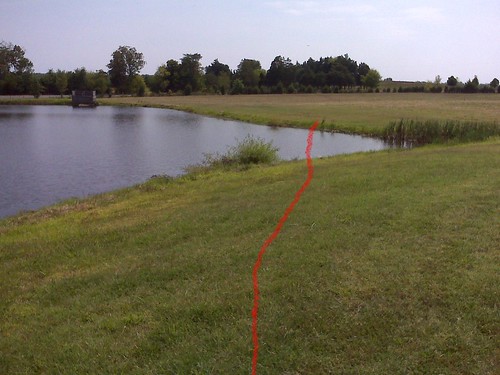 Series C's 70-yard memory-bird
Series C's 70-yard memory-bird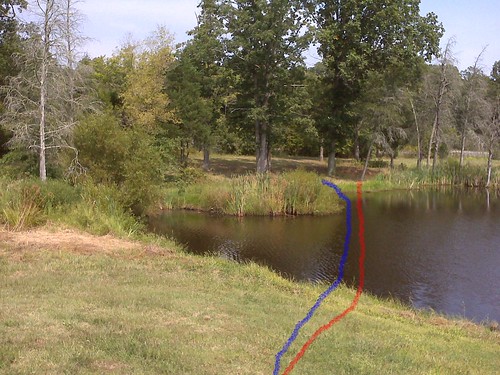 Series C's 50-yard single, showing Laddie's line in blue and Lumi's line in red
Series C's 50-yard single, showing Laddie's line in blue and Lumi's line in red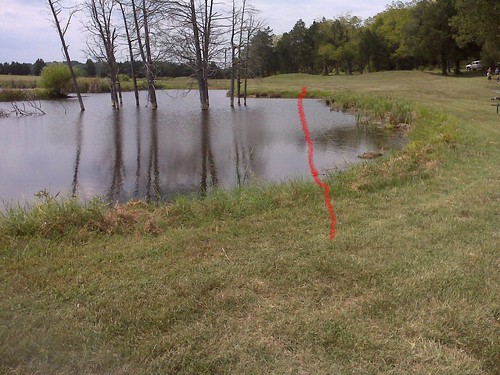 Series C's 60-yard blind
Series C's 60-yard blind
